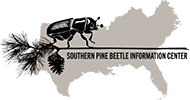Abstract
Southern pine beetle (SPB) (Dendroctonus frontalis Zimm) outbreaks and wildfire occurrence in recent decades has triggered growing concerns regarding their possible interactions. However, few studies have quantified the fuel characteristics of SPB-killed stands, especially the dynamics of the resulting fuel complex. More importantly,
how changes in the fuel complex will affect fire behavior remains unclear. Using field measurements in combination with fire modeling systems, we studied fuel dynamics and its implication to potential fire behaviors by sampling non-outbreak, early post-outbreak (2–3 years), and late post-outbreak (7–8 years) loblolly pine dominated stands in Georgia and South Carolina, USA. We found that the loadings of 1-hr, 10-hr, 100-hr, 1000- hr fuels, and litter depth were significantly greater in post-outbreak stands than in non-outbreak stands. Stand structure was altered in post-outbreak stands, which contained fewer live pines and more hardwoods. We used the Fuel Characteristic Classification System (FCCS) combined with actual data to construct representative fuel beds from the field data. These customized fuel beds were then used to model surface fire behavior that could be altered by the changes in fuel loading and stand structure resulting from SPB outbreaks. Both FCCS and BehavePlus fire modeling systems predicted a faster rate of spread and longer flame lengths in post-outbreak stands than in non-outbreak stands. Late post-outbreak stands under extremely dry conditions were predicted to have the most extreme fire behavior. Our results fill a critical knowledge gap, which will help forest managers make informed decisions on the management of loblolly pine-dominated stands after the southern pine beetle outbreak.
Keywords
Fuel dynamics, Fire behavior, Loblolly-dominated forests, Southern pine beetle outbreaks, Piedmont
To read the full article please visit the link below:
Xie, Hongtao, Jennifer E. Fawcett, and G. Geoff Wang. 2020. “Fuel Dynamics and Its Implication to Fire Behavior in LoblollyPine-Dominated Stands after Southern Pine Beetle Outbreak.” Forest Ecology and Management466 (June): 118130. https://doi.org/10.1016/j.foreco.2020.118130.
